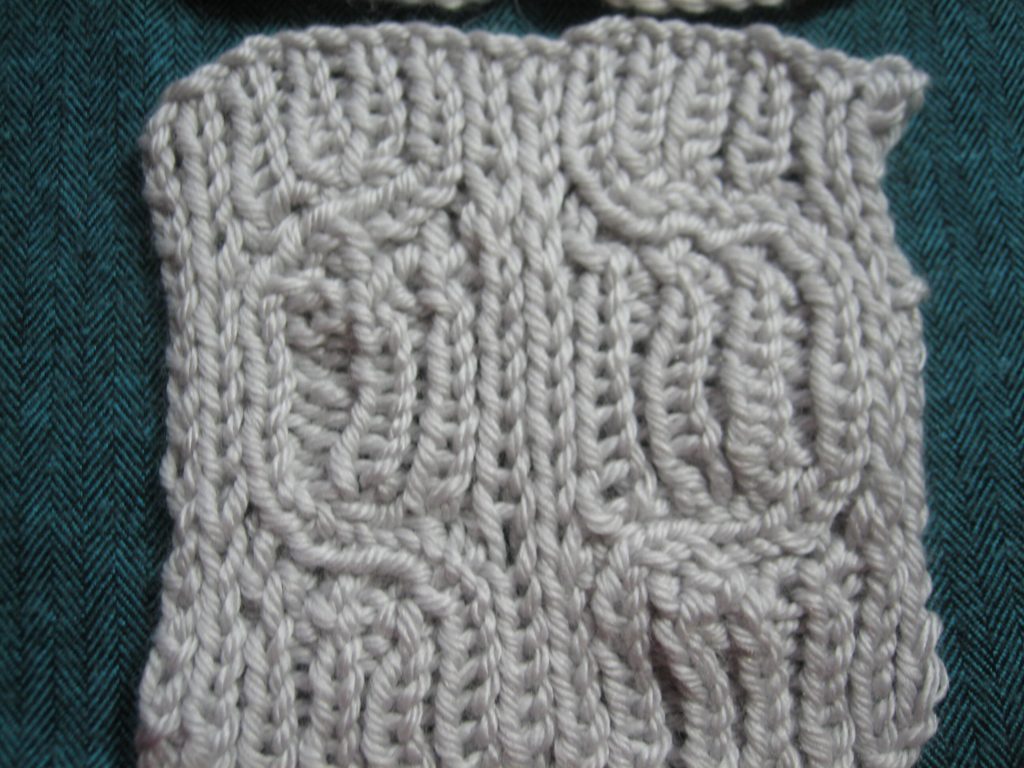I introduced the Short Row Slide idea in this post, it’s a way of making a column of ribbing look as if it were sliding horizontally. The individual slides are all explained with written instructions and charts in the (soon to be released) patterns, but I wanted to explain how and why I dealt with each field. I wrote about dealing with Garter Stitch in last post. My friend Lindsay suggested that I learn how to make a video to illustrate these, so, ahem. I’ll be learning new things really soon.


The abbreviation code works like this:

a. L or R for left or right leaning slide for the bordering rib between the ogees as it rises
through the fabric.
b. In this part of the abbreviation, the field of fabric is listed as you come to them in your knitting. This is where knitting and English confuse each other; in the code the fields are listed left to right, but you come to them in your knitting from right to left. I read them out loud to myself, then follow that order on my needles when I’m proofing my pattern, when I’m knitting, I just read the stitches. The types of fabric fields you will encounter
are:
- g for garter
- P for reverse stockinette field
- K for stockinette field
- kpk for K1, p1, k1 ribbing
- pkp for P1, k1, p1 ribbing
c. the number of stitches that are sliding horizontally.
To explain how the slides work, I decided to go from the same field to the same field, but then I needed 3 rib stitches so that they would contrast, not the pairs of ribbed stitches I used in Al-Andalus, Octans and Habib; where I was going from stockinette to reverse stockinette. With the slides I needed for the Octans shawl, and these blog examples, I added r# for the number of stitches in the rib. In this case, r3 for the three ribbed stitches that are sliding, so a right slide is called srsRribribr3

Ribbed Square-ish Example
Row 1 (RS): (K1, p1) x 13, k1. (27 sts)
Row 2 (WS): (p1, k1) x 13, p1.
Row 3: (K1, p1) x 13, k1.
Row 4: (p1, k1) x 13, p1.
Row 5: K1, p, k, srsRRibRib6r3, k, p, k, srsLRibRib6r3, k, p, k1.
Row 6: (p1, k1) x 13, p1.
Row 7: (K1, p1) x 13, k1.
Rows 8 – 13: Repeat rows 6 – 7.
Row 14: p1, k, p, srsRRibRib6r3, p, k, p, srsLRibRib6r3, p, k, p1.
Rows 15 – 18: Repeat rows 1 – 2.

srsRribribr3
Row 1 (RS): (P1, k1) x 4, p1, LLI. (10 sts)
Row 2 (WS): (P1, k1) x 2, k2tog. (5 sts)
Row 3: Sl wyif, p1, k1, p1, LLIp1.
Row 4: K2, p1, k1, p2tog.
Row 5: Sl, p1, k1, p1, LLI.
Rows 6 – 9: Repeat rows 2 – 5.
Rows 10 – 12: Repeat rows 2 – 4.
Row 13: Sl, (p1, k1) x 4, p1. (10 sts)
While the left and right slides are reverses of each other, in a left slide, you work right up until the ribbing to begin. You do the same thing in a right slide, but the main chart symbol covers up the stitches you are working to get there, so they are included in the mini-chart. It’s a little weird to look at the instructions and have one be so much wider than the other, but that’s how it worked out.

srsLribribr3
Row 1 (RS): P1, k1, p1, p2tog tbl. (4 sts)
Row 2 (WS): Sl, k1, p1, k1, RLI. (5 sts)
Row 3: P2, k1, p1, ssk.
Row 4: Sl wyif, k1, p1, k1, RLIp1.
Row 5: (K1, p1) x 2, p2tog tbl.
Rows 6 – 9: Repeat rows 2 – 5.
Rows 10 – 12: Repeat rows 2 – 4.
Row 13: (K1, p1) x 2. (4 sts)
On the decrease side of the slides, after the turn, the first stitch is slipped so that the strand of yarn crosses on the purled side, which makes it almost disappear into the purl stitch. I could not slip the first stitch on the increase side, because on the following row there will be another lifted increase, and if no new stitch is there, you have to make all 6 increases into the same loop, which gets very tight!
Next I’ll write about working a slide through a stockinette field.
My Patterns Andalus and Habibi use these techniques.
